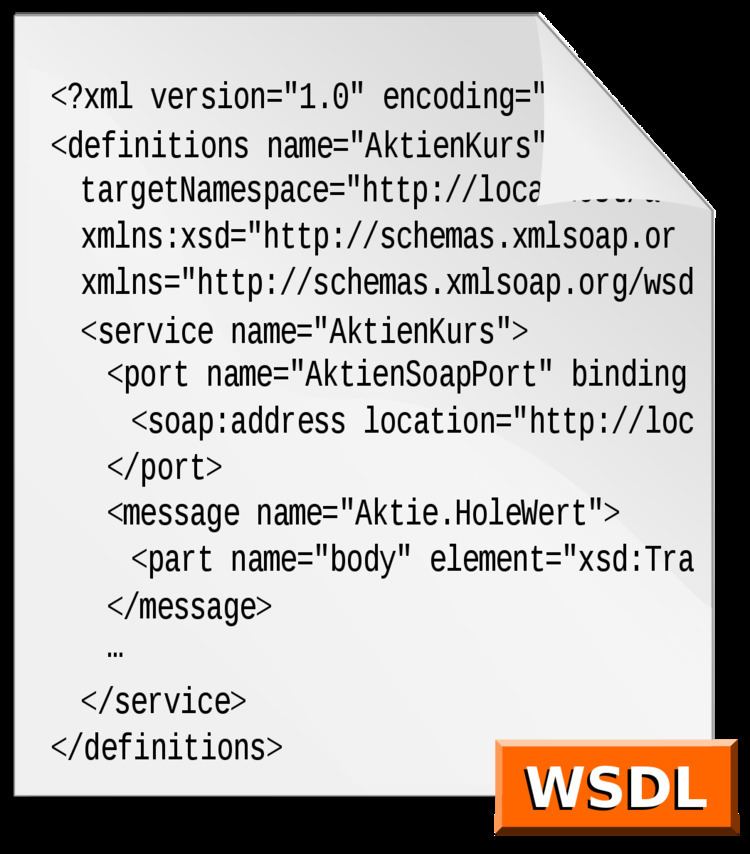Filename extension .wsdl Contained by XML | Internet media type application/wsdl+xml Standard 2.0 Recommendation | |
 | ||
Developed by World Wide Web Consortium | ||
The Web Services Description Language (WSDL /ˈwɪz dəl/) is an XML-based interface definition language that is used for describing the functionality offered by a web service. The acronym is also used for any specific WSDL description of a web service (also referred to as a WSDL file), which provides a machine-readable description of how the service can be called, what parameters it expects, and what data structures it returns. Therefore, its purpose is roughly similar to that of a method signature in a programming language.
Contents
The current version of WSDL is WSDL 2.0. The meaning of the acronym has changed from version 1.1 where the "D" stood for "Definition".
Description
The WSDL describes services as collections of network endpoints, or ports. The WSDL specification provides an XML format for documents for this purpose. The abstract definitions of ports and messages are separated from their concrete use or instance, allowing the reuse of these definitions. A port is defined by associating a network address with a reusable binding, and a collection of ports defines a service. Messages are abstract descriptions of the data being exchanged, and port types are abstract collections of supported operations. The concrete protocol and data format specifications for a particular port type constitutes a reusable binding, where the operations and messages are then bound to a concrete network protocol and message format. In this way, WSDL describes the public interface to the Web service.
WSDL is often used in combination with SOAP and an XML Schema to provide Web services over the Internet. A client program connecting to a Web service can read the WSDL file to determine what operations are available on the server. Any special datatypes used are embedded in the WSDL file in the form of XML Schema. The client can then use SOAP to actually call one of the operations listed in the WSDL file using for example XML over HTTP.
The current version of the specification is 2.0; version 1.1 has not been endorsed by the W3C but version 2.0 is a W3C recommendation. WSDL 1.2 was renamed WSDL 2.0 because of its substantial differences from WSDL 1.1. By accepting binding to all the HTTP request methods (not only GET and POST as in version 1.1), the WSDL 2.0 specification offers better support for RESTful web services, and is much simpler to implement. However support for this specification is still poor in software development kits for Web Services which often offer tools only for WSDL 1.1. For example, the version 2.0 of the Business Process Execution Language (BPEL) only supports WSDL 1.1.
Subset WSDL
Subset WSDL (SWSDL) is a WSDL with the subset operations of an original WSDL. A developer can use SWSDL to access Subset Service, thus handle subset of web service code. A Subset WSDL can be used to perform web service testing and top down development. Slicing of a web service can be done using a Subset WSDL to access Subset Service. Subset Service can be categorized into layers using SWSDL. SWSDLs are used for Web service analysis, testing and top down development. AWSCM is the pioneer tool to construct SWSDL's successfully.
History
WSDL 1.0 (Sept. 2000) was developed by IBM, Microsoft, and Ariba to describe Web Services for their SOAP toolkit. It was built by combining two service description languages: NASSL (Network Application Service Specification Language) from IBM and SDL (Service Description Language) from Microsoft.
WSDL 1.1, published in March 2001, is the formalization of WSDL 1.0. No major changes were introduced between 1.0 and 1.1.
WSDL 1.2 (June 2003) was a working draft at W3C, but has become WSDL 2.0. According to W3C: WSDL 1.2 is easier and more flexible for developers than the previous version. WSDL 1.2 attempts to remove non-interoperable features and also defines the HTTP 1.1 binding better. WSDL 1.2 was not supported by most SOAP servers/vendors.
WSDL 2.0 became a W3C recommendation on June 2007. WSDL 1.2 was renamed to WSDL 2.0 because it has substantial differences from WSDL 1.1. The changes are the following:
